
A/Prof Julian Rait OAM
11 December 2019
The recent release of international hospital rankings by London-based digital healthcare start-up Medbelle has got me thinking. Medbelle has created a ranking of cities from across the world that offer the best overall medical care, as well as creating a benchmark for the rest of the world to understand how to better develop their medical education, accessibility and infrastructure for a healthier future.
So I would like to congratulate all those who have contributed to Melbourne’s hospital system - ranked by Medbelle as 7th in the world - and the best in Australia (with Sydney ranked 11th). However, behind these ratings, it is actually not such ‘a golden time’ in the Victorian public health system.
If we don’t maintain pressure on our governments to continue to invest in and prioritise the public health system, their attention will drift elsewhere. And while the Federal Government is obsessed with achieving and maintaining a budget surplus, other things like tunnels, roads and bridges have attracted the fond attention of our state Premier and Treasurer.
Inevitably the public health system suffers from these policy decisions. We’re seeing evidence of this lately in Victoria. Despite claims from the State Government of record investment, this past year we have seen an operational funding crisis in many of our public hospitals.
Consequently, it’s a tale of two cities; it is the best of times, and it is the worst of times. On the one hand, the State Government has announced that our health funding is at record levels. On the other hand, our members tell us that the system is more constrained than ever, and under enormous pressure from ever increasing demand for hospital care.
Public hospitals continue to call on staff to work smarter and find savings - which staff have done, year on year for nearly a decade. Meanwhile we’re hearing from many of our members in our hospital wards and in our emergency departments that there is simply no more to give.
For a decade, we have had increasing demands to improve throughput, improve performance and improve efficiency – but is there really more that we can do with our current infrastructure and resources? There comes a point when to work smarter, the system needs more investment, more beds, more staff - not the application of more stress through cost cutting and high-handed rhetoric.
In many respects, a perfect storm is brewing in Victoria – booming and ageing population pressures, an exodus from the private health sector and insufficient support for GPs to better manage chronic disease.
Equally, there has been no new investment to address the Victorian mental health crisis into which the State Government called a Royal Commission during the last state election campaign, while access to effective treatment for patients and their carers worsens.
The pressures are being felt in other areas as well. Whilst the Victorian State Government has gained a great deal of kudos with its focused investment on transport infrastructure, it has taken its eye off our public hospital infrastructure needs across the state.
The state’s public hospital infrastructure is ageing - with no clear strategy in place for upgrading, improvement or renewal. Health requires complex buildings. They need to be flexible and need to be built to evolve as technology develops, the delivery of care changes, and the community’s expectations shift. Many of the state’s older public hospital buildings are at end-of-life and are severely constrained in their ability to meet the standards expected in the delivery of healthcare in 2020 and beyond.
Similarly, the management of public hospital assets and equipment requires huge investment to ensure end-of-life infrastructure does not fail; nor should hospitals have to draw on operational funding to pay for the replacement and upgrading of equipment. As we have seen this year at both the Alfred and Austin Hospitals, when critical public hospital infrastructure fails, quality and safety can be compromised and public confidence in the system is undermined.
The AMA agenda for 2020 is to urgently advocate on these issues in a way that pressures the Victorian State Government to prioritise public healthcare; to reappraise its priorities and review its spending. We will endeavour to ensure that the operational and infrastructure needs of the public health system are maintained at a level that will meet Victoria’s current and future needs. We will also do this in a way that engages the broader public, for it is their health and equitable access to care that we are most concerned about.
And finally, thank you for working with the AMA during 2019. Powerful advocacy relies on high-level and meaningful engagement with the medical profession and our members. Your insights and ideas have shaped our policy platform and have informed our conversations with government; your shared stories and experiences have helped build our media campaigns. We will build on this work and continue to work with our members to advocate strongly to government throughout 2020 to achieve better outcomes for the Victorian health system and for the healthcare of our community.
I have thoroughly enjoyed engaging with you all and wish our members and staff a pleasant and relaxing festive season along with an exciting and productive New Year.
A/Prof Julian Rait OAM
AMA Victoria President
This article appears in the Summer 2019/20 edition of Vicdoc.
